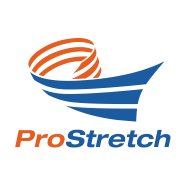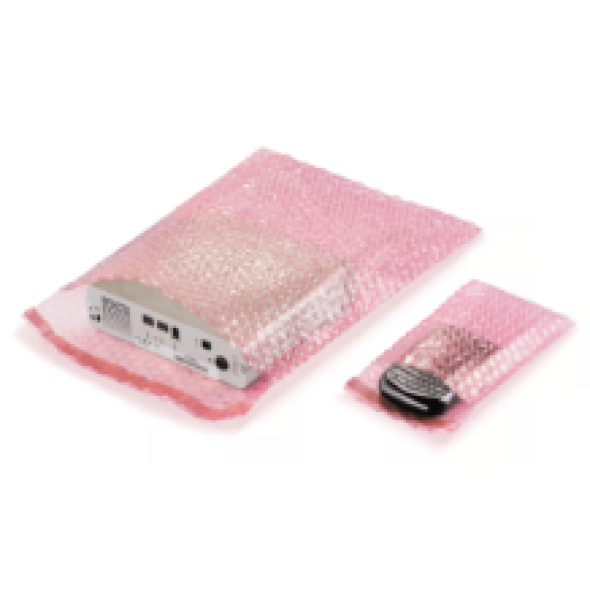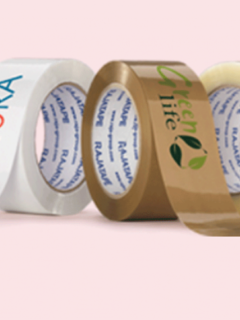Stretch film is one of the most common methods of securing cargo units. The European annual consumption of stretch film is over 1.3 million tonnes, in Germany alone as an exporting country 160,000 tonnes – and the trend is rising.
Securing pallets with stretch film: How does it work?
Stretch film is used to secure individual packages on a pallet and connect them to form a load unit. Because: If the individual packages slip or tip over, not only are the goods damaged, but the safety of the people working with the load is literally on the line.
Stretch film: A lot helps a lot?
The figures prove large quantities of use. So German industrial companies are wrapping and stretching for all they’re worth. But does the stuff really hold up?
The decisive factor is not so much the amount of material, but the quality of the film and the right way of applying it.
Stretch film offers the highest possible stability if it is only stretched (i.e. stretched) directly during application, as this is exactly when it forms the necessary restoring force to secure the load. No matter how hard you try, manual wrapping can never achieve the same restoring forces that are achieved when using an automatic stretching machine. Manual stretch wrapping is therefore primarily for protection against dust and moisture, not so much for securing the load.
Pre-stretched stretch film
Securing cartons or other individual parts on a pallet is a bit like coaching a sports team: the stronger the individual participants stick together, the better the overall performance. Your task as a “coach” is to place each individual in the optimal position for him or her (see blog on “Optimal pallet loading“) and then to ensure that the individual parts grow together to form a team, i.e. to create cohesion.
In the case of packaging, pre-stretched stretch film is one of the simplest and most effective solutions for this. It protects against dust and moisture, offers protection even for irregular and sharp-edged loads and keeps your pallet in shape.
What makes pre-stretched stretch film so special now?
The film, supplied on rolls or spools, is stretched as it is unwound. It behaves elastically and wants to return to its initial tension, similar to a stretched rubber band. The force that is developed in the process is called retensioning force ( = the film wants to contract longitudinally) or tapering ( = the film wants to contract in width and thus becomes narrower again).
Obviously, the more the film has been stretched (some can withstand stretching of up to 250%!), the stronger the retensioning force and the greater the stability of the pallet. And this is where the clear advantage of mechanically pre-stretched stretch film becomes apparent: Since the maximum stretch is achieved here (i.e. always significantly more than you will achieve by hand with all your pulling and tugging…) and the pre-stretched film remains constant in width, i.e. the tapering is minimal, you stretch around the same surface with less film and thus save material and costs.
The best thing is: you achieve this optimal result with a minimum of time and effort! And that’s really always good, whether you’re wrapping or playing sports!
Automatic stretching
Automatic stretching, for example with a mobile pallet wrapper, on the other hand, provides adequate load securing. The mobile helper pays attention to the two “weak points” of a load unit with separate head and foot wrapping. What sounds a bit like emergency medical care is crucial for stability:
The foot winding during stretching
To achieve a stable cargo unit, the connection to the load carrier, usually a pallet, is crucial. We recommend at least 8-12 “foot wraps” for a stable connection, preferably in two steps, i.e. once before the actual wrapping process, once afterwards.
The head winding during stretching
The upper packages are exposed to high centrifugal forces, for example when the truck brakes. Sufficient stabilisation of the upper cargo area is therefore necessary. While two wraps are usually sufficient for the middle part of the pallet, 4 to 5 wraps are recommended here, depending on the weight.
Cross wrapping during stretching
Ideally, the stretch film is first guided along the load in an upward movement, then in a downward movement. The resulting cross-wrapping ensures optimum stability. Here, the two layers of intersecting film are usually sufficient to secure the load against tipping and slipping:
A well-wrapped pallet weighing around 440 kilograms withstands an angle of 34 degrees of inclination in the tipping test and thus forces of around 0.67 g – more than are generated by an evasive movement with the LWK.
Stretch film – manufacture
ProStretch – Tested stretch films
The ProStretch initiative declared war on the irregularities in the stretch film market 14 years ago and did so quite successfully. The initiative was founded in 1997. It is organisationally affiliated to the IK Industrievereinigung Kunststoffverpackungen e.V., the largest association within the European plastic packaging industry. and in it leading manufacturers and distributors of stretch films have joined forces.  The primary goal is to achieve cooperation with customers based on trust and partnership. The reason for the foundation was the ever increasing irregularities in the film market. For example, “coded” offers such as the type designation of films are sometimes not clear enough for the customer and make price comparisons almost impossible. Another reason are short deliveries in thickness and length of the film. As a result of checks, customers have sometimes received up to 30% less than they ordered. This not only puts customers at a disadvantage, but also considerably restricts the activities of honest competitors.
The primary goal is to achieve cooperation with customers based on trust and partnership. The reason for the foundation was the ever increasing irregularities in the film market. For example, “coded” offers such as the type designation of films are sometimes not clear enough for the customer and make price comparisons almost impossible. Another reason are short deliveries in thickness and length of the film. As a result of checks, customers have sometimes received up to 30% less than they ordered. This not only puts customers at a disadvantage, but also considerably restricts the activities of honest competitors.
One of the first steps was to draw up a supplier declaration with binding tolerances. In this declaration, all members of the initiative undertake to directly mark essential parameters such as length, width, thickness and weight on the packaging. This creates comparability and transparency for the customer. All ProStretch members undertake to mark their films clearly and unambiguously and also to maintain very low tolerances. This gives the customer a legal possibility to take action against a short delivery and the resulting financial losses. In addition, the ProStretch initiative plans to provide customers with permanent information on a wide range of topics, such as legislative procedures and market developments. But the ecological and economic advantages of stretch film should not be neglected either.
A unique programme has been developed so that the customer can also check the supplier’s information: With its help, the delivery is compared with the order. Simply call up the test on the Internet, enter all the data and the programme calculates any discrepancies and the economic loss the customer suffers as a result. In addition, a sample letter is offered for download, which makes it easier to complain to the supplier.
In the meantime, more than 30 well-known manufacturers and retailers who adhere to the supplier declaration belong to the initiative. But there are still “black sheep” on the market. Therefore: Watch out when buying film – look for the ProStretch logo!
Types of stretch film
The blown films include, for example, super-adhesive stretch film. It is tear-resistant, cold-resistant and particularly suitable for stretching pallets that have protruding or jutting corners and edges. It holds loads perfectly in position. It also makes it very easy to stretch particularly bulky products such as castings and machines or even oversized goods. If you need to do it particularly quickly, it’s best to use pre-stretched film: also produced in a blow-moulding process, it takes around 20 percent less time to secure the goods for transport and at the same time saves half the material. Because of the pre-stretching, almost no force is required.
But it is not only the type of film that is decisive, but also its thickness. While a film thickness of only 15 micrometres (?) is sufficient for a product weighing up to 300 kilograms, 20 micrometres are required when the weight doubles. From a load of 800 kilograms, a film thickness of 30 micrometres is appropriate.
Stretch netting – the special way of stretching
There are numerous products for which air circulation must also be ensured during transport, such as plants, chilled or frozen products, fruit and other foodstuffs. If you were to work with conventional stretch film when palletising these products, you would quickly have to deal with moisture, condensation and the associated problems. For these special applications, there is stretch film with holes – the so-called “stretch film”. Stretch net.
This not only fixes the pallet loads securely but also ensures the right climatic conditions. And all this without much effort! In addition, the flexible net adapts optimally to “misshapen” pallet loads. Even unevenly shaped products and loads can be optimally fixed. And it is extremely efficient: due to its high stretchability, up to 75% more length can be achieved and with only 4.2 g per running metre, it is also a real lightweight.
The holes in the film ensure air and heat exchange during transport and storage. Hot packaged products such as drinks or canned food can thus cool down during transport. The holes in the film prevent condensation from forming. Flowers and vegetables do not sweat and stay fresh longer instead of wilting during transport. Frozen products freeze through more quickly during cold storage because the stretch net does not insulate the product but allows the cold to reach the goods. This ensures both a shorter freezing and thawing time.
Coloured stretch film – what’s the point?
With coloured film in yellow, red, blue you can sort and clearly mark your pallets in the logistics area. With the help of different foil colours (6 colours are available at RAJA), incoming and outgoing goods can be distinguished in the warehouse or individual pallets can be differentiated according to postal codes. Due to the colourful design, confusion during shipping is almost impossible. This creates an overview!
With coloured stretch film you can not only secure your goods, but also protect them from UV radiation and prying eyes. In this way, your products are protected against theft during transport right through to storage.
This is how the vending machine wraps:
Want to watch the automatic pallet wrapper at work? Click here for the film!
















